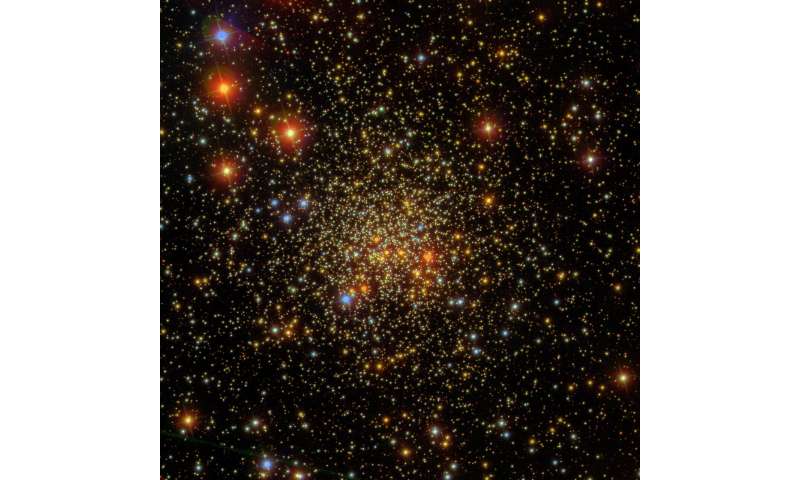
Using data from ESA's Gaia satellite, astronomers have investigated a low-metallicity galactic open cluster known as NGC 2158. The study, presented in a paper published December 11 on the arXiv pre-print server, provided important information about the properties of NGC 2158 and identified hundreds of the most likely cluster members.
Open clusters (OCs) are groups of stars loosely gravitationally bound to each other that form from the same giant molecular cloud. So far, more than 1,000 of them have been discovered in the Milky Way, and scientists are still looking for more, hoping to find a variety of these stellar groupings. Studying galactic open clusters in detail could be crucial for improving the understanding of the formation and evolution of the galaxy.
NGC 2158 (other designations: OCL 468, Lund 206 and Melotte 40) is an old, low-metallicity OC located at the Milky Way's periphery. The cluster is about 14,700 light years away, and its age is estimated to be some 2 billion years.
A team of astronomers led by Devesh P. Sariya of the National Tsing-Hua University in Hsin-Chu, Taiwan, analyzed the data from the second Gaia Data Release (DR2) in order to learn more about the properties and nature of NGC 2158.
"In this paper, we have done photometric and kinematical analysis of old open cluster NGC 2158 using Gaia DR2 data," the researchers wrote in the paper.
The study found that NGC 2158 is located even farther away than previously thought—at a distance of approximately 15,290 light years. The cluster's limiting radius and log (age) were estimated to be 23.5 arcmin and 9.38 billion years, respectively.
According to the paper, NGC 2158 has a mass function slope at a level of 0.93 within the mass range of 1.17 to 1.44 solar masses, and shows the mass-segregation effect. The relaxation time for NGC 2158 was calculated to be about 585 million years, which suggests that the cluster is dynamically relaxed.
The astronomers managed to identify around 800 member stars of NGC 2158, with membership probability of above 90%. The mean proper motions of the cluster were measured to be -0.2 and -1.99, in right ascension and declination directions, respectively. In general, it was found this OC moves almost in the Solar antapex direction.
By investigating the orbit of NGC 2158 the researchers shed more light on the origin of this cluster.
"NGC 2158 orbit is consistent with disk kinematics, leading us to discard the possibility that the cluster is accreted. Its metallicity is not inconsistent with the position in the disk. This gives no support to the possibility that the current location of the cluster in the disk is due to migration," the authors of the paper concluded.
© 2020 Science X Network
Citation: Open cluster NGC 2158 investigated in detail (2020, December 21) retrieved 21 December 2020 from https://ift.tt/3p8ZxLZ
This document is subject to copyright. Apart from any fair dealing for the purpose of private study or research, no part may be reproduced without the written permission. The content is provided for information purposes only.
"open" - Google News
December 21, 2020 at 09:00PM
https://ift.tt/3p8ZxLZ
Open cluster NGC 2158 investigated in detail - Phys.org
"open" - Google News
https://ift.tt/3bYShMr
https://ift.tt/3d2SYUY
Bagikan Berita Ini














0 Response to "Open cluster NGC 2158 investigated in detail - Phys.org"
Post a Comment